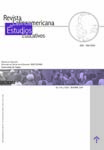Authors
Abstract
The following article, part of the first research results on the teaching of digital aesthetics presented as a thesis in the Master of Education with Emphasis in Multimedia at the Universidad de Caldas. This research journeys through the history and the central categories in the context of contemporary representation forms. In this sense, the article seeks to relate these theoretical positions with the experiences and conceptions of the professors in charge of digital media courses in Visual Arts programs of the coffee-growing region, and thus propose a reflection that generates starting points in search of a teachability of Digital Aesthetics.
References
Baudrillard, Jean. (1993). Cultura y simulacro. Barcelona: Kairos.
Benjamín, Walter. (1936). Ensayo: “La obra de arte en la era de la reproducción mecánica”. [consultado el 20 de noviembre de 2008]. Disponible en: www.bienalfindelmundo.org/.../laobradearteenlaepocadesureproductibilidadtecnica.pdf
Blázquez, Niceto. (2008). El uso de la razón. Madrid: Visión Net. p. 258.
Castaño, Alés E. (2000). Investigación sobre los orígenes del arte cibernético en España. Alicante: Biblioteca Virtual Miguel de Cervantes.
Deslauriers, Jean Pierre (2005). Investigación Cualitativa. Pereira: editorial Papiro.
Echeverría, Javier. (1994). Telépolis. Barcelona: Ediciones Destino, S.A.
Giannetti, Claudia. (2002). Estética digital. Barcelona: Asociación de cultura contemporánea.
Giannetti, Claudia. (2008). “Aesthetic Paradigms of Media Art”. Alemania. [Consultado en enero de 2008]. En: http://www.medienkunstnetz.de/themes/aesthetics_of_the_digital/aesthetic_paradigms/scroll/
Hernández, Iliana. (2003). Imagen numérica y creaciones electrónicas, Bogotá: U. Javeriana.
________. (2005a). Estética, Ciencia y Tecnología. Bogotá: Editorial Pontificia Universidad Javeriana.
________. (2005b, Ene.-Dic.). “Mundos virtuales interactividad e imagen numérica”. Revista KEPES, Año 2 No. 1. pp. 123-137.
Lévy, Pierre. (1997). Cibercultura: Informe para el Consejo de Europa. Barcelona: Anthropos.
________. (1999). ¿Qué es lo virtual? Barcelona: Paidós.
________. (2004). “Inteligencia Colectiva. Por una antropología del ciberespacio. Figuras de espacio y de tiempo”. [Consultado en Abril de 2008] en: http://inteligenciacolectiva.bvsalud.org/?lang=es
Lizarralde, Christian. (2008). Conferencia. “La virtualización sensorial”. Museo de Arte de Pereira.
Londoño, Felipe C. (2005, Ene.-Dic.). “Interficies de las comunidades virtuales”. Revista KEPES, Año 2 No. 1. pp. 57-92.
Montagu A, Pimentel D, Groisman, M. (2004). Cultura digital: comunicación y sociedad. Buenos Aires: Paidós.
Morin, E. (1990). Introducción al Pensamiento Complejo. Barcelona: Editorial Gedisa, S.A.
Moreno, Isidro. (2003). Musas y nuevas tecnologías, el relato hipermedia. Barcelona: Paidós.
Muñoz. L. J. (2007). Ensayo sobre el nuevo ser Virtualizado. Línea de investigación COCUES. Pereira: UCPR.
Narváez, Ancizar. (2005) Sujeto, cultura y dinámica social, ¿Qué entender por cultura? P.197 Bogotá: Antropos.
Negroponte, N. (2001). El mundo digital. Barcelona: Grupo editorial Norma.
Pena Vera, Tania y Pirela Morillo, Johann. (2007, Ene.-Jun.). “La complejidad del análisis documental”. Inf. Cult. Soc., 16: 55-81. ISSN 1851-1740.
Pereira, J. M. (2005). Tecnocultura y Comunicación. Bogotá: Editorial Universidad Javeriana.
Rojas Soriano, Raúl. (1999). Guía para realizar investigaciones sociales. México P.E. plaza y valdes.
Rodríguez, Jaime A. (2002). El hipermedia narrativo. Tecnocultura y Comunicación. Bogotá: U. Javeriana.
Schultz, Margarita. (2006). Filosofía y producciones digitales. 1 ed. Buenos Aires: Alfagrama.
Silva, Marco. (2005). Educación Interactiva, enseñanza y aprendizaje presencial y On – line. Barcelona: Gedisa.

 PDF (Español)
PDF (Español)
 FLIP
FLIP



















